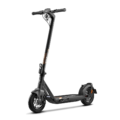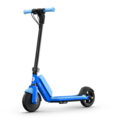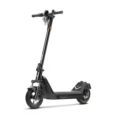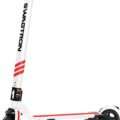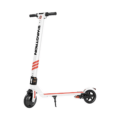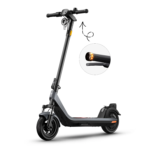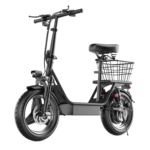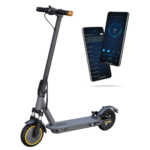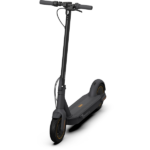- Home
- Scooters
- Electric Scooters
- NIU KQi Youth+
NIU KQi Youth+
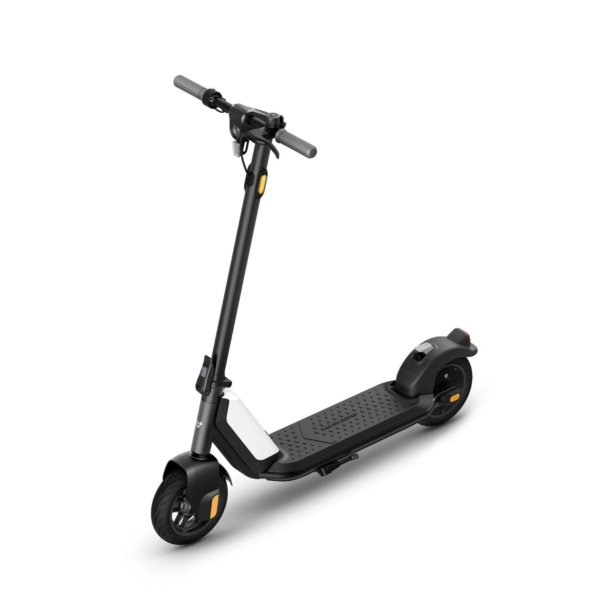

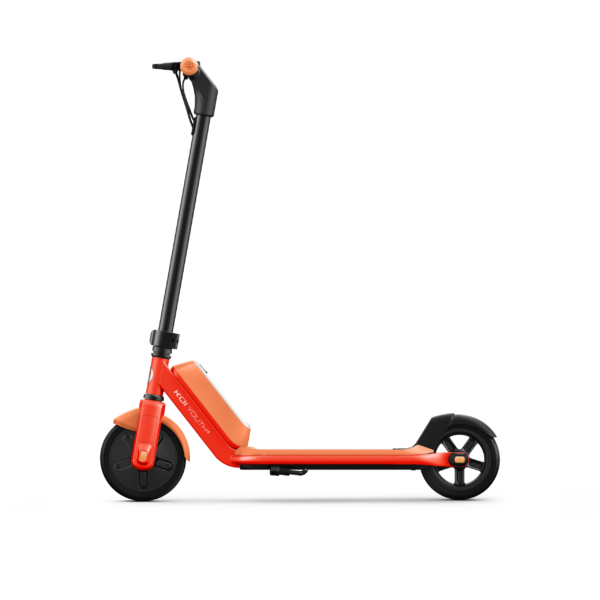
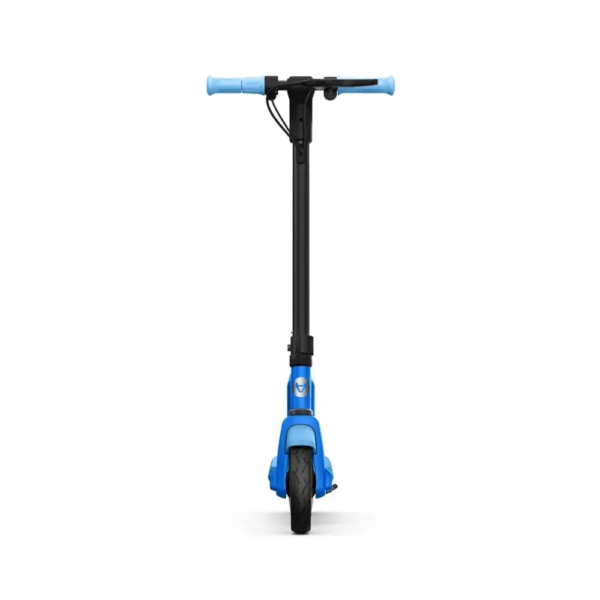
- Battery Range: 7.1 miles / up to ~70 minutes
- Top Speed: 10 mph (16 km/h)
- Motor Power: 150 W rated
- Weight Capacity: 132 lb (60 kg)
- Charging Time: 4 hours
- Scooter Weight & Portability: 18.3–18.5 lb (8.3–8.4 kg)
PROS
- Two speed modes (Safe/Sport) with gentle throttle mapping
- Dual brakes: smooth front electronic + simple rear foot brake
- Flat-proof AirStryke tires; no punctures and low maintenance
- Bright light ring for visibility and battery indication
- Lightweight, compact, and easy to store or transport
CONS
- No headlight; daylight or well-lit path riding recommended
- Non-folding stem means taller storage footprint
- Limited top speed and hill power (by design for safety)
Introduction: A Bigger Kids’ Scooter That Keeps Speed Sensible
The NIU KQi Youth+ Specifications describe a compact, confidence-building scooter designed for growing riders. It keeps the fun high and the complexity low. Because kids between 8 and 14 change quickly in height and coordination, the Youth+ pairs a gentle 150 W rated motor (with 200 W max) to smooth throttle mapping and two capped speed modes. As a result, new riders can start slowly in Safe Mode and then, when ready, switch to Sport Mode for a top speed of 10 mph. That ceiling feels exciting in parks and cul-de-sacs yet remains manageable for developing skills.
Moreover, the chassis fits the target age range without feeling flimsy. The scooter weighs about 18 lb, so parents can move it with one hand and kids can push it easily. The non-folding stem keeps the front end rigid—important when kids are still learning steady steering. Meanwhile, the AirStryke solid/PU tires stay flat-proof, which matters more than ever when a ride depends on short play windows after school.
In short, the Youth+ aims to be a “just right” first real e-scooter for older kids: simple to learn, safer to control, and easy to live with every day.
Sizing & Fit: Why Youth+ Exists Next to Youth
NIU offers both the Youth and Youth+ because not every kid fits the same geometry. The Youth+ targets 8–14-year-olds at roughly 52″–63″. That height window gives the handlebars a natural reach, so elbows relax and shoulders stay neutral. Because the handlebar height is fixed, picking the version that matches a child’s height matters more than chasing an adjustable stem.
Furthermore, the deck length (15.7″) and narrow bar width (14.4″) let riders place both feet comfortably without spreading their stance too wide. This compact footprint keeps the center of mass low, which helps kids balance at slow speeds and during gentle turns. Consequently, early rides feel less wobbly and more predictable.
Parents can also handle storage with less fuss. Since the stem uses a quick-release vertical tube rather than a folding latch, there are fewer moving parts to loosen. The scooter parks neatly against a wall, slides into a closet corner, or rides in a trunk diagonally. Because it is light, even younger siblings can help carry it short distances.
Power & Modes: Calm Starts, Easy Confidence
A kids’ scooter should never lurch. Therefore, the Youth+ uses smooth throttle mapping that brings riders off the line gently. In Safe Mode (up to 6.2 mph), beginners have time to look ahead, learn hand position, and practice rolling off the throttle before corners. Then, when control is consistent, Sport Mode raises the cap to 10 mph. The change is noticeable and fun; however, the scooter still encourages steady pacing rather than rapid sprints.
Because the hub motor sits in the front wheel, it responds quickly at low speeds and also helps slow the scooter with electronic regenerative braking. That dual behavior—gentle drive and gentle slow-down—teaches a clean rhythm: add a little power, look ahead, then ease off and squeeze the lever sooner rather than later. Over time, kids internalize this pattern and carry it into bikes and, eventually, bigger rides.
As for hills, the Youth+ handles neighborhood rolls and driveway ramps. Steeper grades will slow it, which is expected at this power level. Yet that limitation can be a positive because it nudges families toward safer routes with smoother surfaces.
Battery & Range: Built for Real Play Sessions
Older kids tend to ride in bursts—loops around the block, community path laps, or short park sessions. The Youth+ battery supports about 7.1 miles or roughly 70 minutes of typical use per charge. In practice, that covers several short rides before it needs a refill. Because the pack charges in about 4 hours, you can plug it in after dinner and have it ready by morning.
Importantly, the Youth+ avoids the pitfalls that drain small batteries fast. First, the capped speed keeps power draw under control. Second, the solid/PU tire construction reduces rolling losses from under-inflated tubes. Third, the scooter is relatively light, so the motor doesn’t burn energy moving excess mass. As a result, kids get reliable range and parents get predictable routines.
If your climate swings cold, range will dip a bit—as with any lithium battery. Even so, the Youth+ remains very usable for short rides. A simple pre-ride habit helps: check the light ring for battery indication, set expectations for the route, and return home before the pack is low. That routine keeps range anxiety out of family time.
Tires & Ride Feel: Flat-Proof, Kid-Proof
Nothing ends a play session like a flat. Because of that, NIU uses AirStryke tires—a layered design that pairs a solid rubber exterior with PU cushioning inside. The front wheel is slightly larger (~7.5″) than the rear (~7.0″), which helps roll over sidewalk seams and small cracks. Although solid tires can’t float over bumps like big pneumatic ones, this construction softens sharp edges well enough for the scooter’s modest speeds.
Additionally, the absence of tubes means no slow leaks, no weekly pump checks, and no surprise punctures from thorns or glass. Parents avoid the patch kits; kids avoid the downtime. Because the tire profile is relatively narrow (~1.5″), steering stays light and responsive, which helps with slow-speed balance drills in Safe Mode.
Set expectations clearly: this is a kids’ platform tuned for learning and casual fun, not for rough trails. However, for sidewalks, driveways, and park paths, the AirStryke setup hits a very practical sweet spot—firm enough to teach balance, cushioned enough to be comfortable, and durable enough to last.
Braking & Control: Two Simple Systems That Teach Good Habits
The Youth+ gives young riders two brakes that are easy to understand. The front electronic brake slows the scooter smoothly when they roll off the throttle and squeeze the lever. Then, the rear foot brake adds extra stopping power with a simple press. Because the first phase is gentle and the second is intuitive, kids learn to look ahead, ease off early, and finish the stop smoothly.
This two-stage feel also helps on less-than-ideal surfaces. Painted crosswalks, wet leaves, and dusty corners reduce grip. A smooth electronic slowdown helps riders stabilize before the foot brake finishes the stop. Over time, kids begin to anticipate surface changes and adjust earlier—one of the most valuable road skills they can learn at this age.
Steering confidence matters, too. The non-folding stem keeps the front end solid, so bars don’t feel loose or vague. The narrow 14.4″ handlebar width keeps inputs small and precise, which reduces wobble when kids get tired.
Lights, Visibility & Weather: Fun That Serves a Purpose
The Youth+ trades a full headlight for a bright light ring that kids love to use. It’s more than decoration. It shows battery level, charging status, and brake indication, and it adds visibility in shade and at dusk. Since this scooter is meant for parks and neighborhood loops—not after-dark urban riding—the ring does its job well. Still, build good habits: ride in daylight, use reflective clothing if light fades, and avoid busy streets.
Meanwhile, the IP54 rating adds resiliency for drizzles and splashy sidewalks. Families should still skip heavy rain and standing water, yet that level of protection means a damp afternoon doesn’t ruin plans. It also helps the scooter age better in climates with mist, fog, or frequent sprinklers.
Everyday Living: Storage, Transport & Setup
Family gear needs to be simple. Because the Youth+ is light and compact, it’s easy to move from garage to car to park. The quick-release vertical tube lets you reduce height for transport without relying on a full hinge; therefore, the structure stays tighter over time. For daily storage, a wall hook or a small floor stand works well. In apartments, a corner near the door keeps it handy but out of the way.
Setup is straightforward. Out of the box, parents attach the bar, confirm fasteners are snug, and charge the battery fully the first time. The box includes two grip-tape patterns, which turns the “my scooter” moment into a small personalization ritual. That bit of ownership often encourages careful use and regular pre-ride checks.
Teaching Good Habits: A Short, Effective Progression
Kids learn fastest when the environment is predictable. Start in a quiet cul-de-sac or a park loop, set Safe Mode, and practice a few basics: relaxed elbows, light grip, and eyes looking where you want to go. Then, add a braking drill—roll on the throttle gently, look ahead, ease off early, and combine the electronic brake with a light press on the rear foot brake. Repeat until it’s smooth.
After a day or two, switch to Sport Mode, keep the same course, and stress looking far ahead. That visual focus is the anchor for all confident riding. Finally, layer in simple signals—hand out for turns, glance back before changing line, and step off the deck calmly when stopping. Keep sessions short and positive; end on a success.
Maintenance & Care: Minimal by Design
The Youth+ minimizes chores. With solid/PU tires, flats disappear. The front electronic brake needs no pad swaps. The rear foot brake is a durable molded piece with a long service life. Routine care comes down to wiping dust, keeping the deck grip clean, and occasionally checking the quick-release and axle nuts for snugness.
Charging is simple and safe. Because the pack is small, avoid deep discharges; regular top-ups prolong battery health. Charge on a hard surface, keep cords tidy, and store the scooter indoors away from heat. If something feels loose, fix it early; a quick turn of a wrench prevents long-term wear.
How It Compares: Youth vs. Youth+ and Other Kids’ Models
Within NIU’s own lineup, the Youth and Youth+ share the same core formula: capped speeds, dual brakes, flat-proof tires, and IP54 weather protection. The primary difference is fit. If your rider is shorter and still building balance, the Youth can be the right size. If your rider is taller or already confident on bikes and boards, the Youth+ fits better and feels more natural in reach and stance.
Against other kids’ scooters, the Youth+ stands out with its light ring, two-mode speed control, and dual braking that feels smooth and progressive. Many competitors either run a single mechanical brake or omit a clear battery indicator. Others use very small hard wheels that feel skittish. The Youth+ takes a more thoughtful approach: gentle power, clear feedback, and kid-first ergonomics.
If you’re comparing to teen scooters, remember the mission. Teen-focused models are faster, heavier, and require stronger braking skills. The Youth+ keeps top speed sensible and the structure light, which aligns better with neighborhood riding and family supervision.
Value: What Families Actually Get
On paper, the Youth+ can look basic next to adult scooters with apps and big batteries. However, for families, the real value is fit, safety, and low stress. You get a scooter that starts reliably, charges quickly, and avoids flats. Kids get a clear path to progress—Safe Mode to Sport Mode, gentle throttle, and two simple brakes. Parents spend less time on maintenance and more time riding together.
Longevity extends the value further. The frame is sturdy, the parts list is short, and the tires cannot puncture. When one child outgrows it, a younger sibling can step in—swap the grip tape pattern for a “new” feel and repeat the same learning plan.
Final Verdict
The NIU KQi Youth+ Specifications reveal a kids’ scooter tuned for growing riders who need structure and confidence, not raw speed. With 150 W of gentle power (and 200 W max), two speed modes, front electronic + rear foot brakes, flat-proof AirStryke tires, and IP54 weather resistance, it creates a safe space to learn and enjoy neighborhood rides. The light ring adds visibility and makes battery checks simple. The non-folding stem keeps steering solid. Charging is quick, storage is easy, and maintenance is minimal.
If your rider is within the 8–14 age range and ready for an e-scooter that feels fun yet manageable, the Youth+ is a smart pick. Start in Safe Mode, practice smooth braking, and move to Sport Mode when control is steady. For a first electric scooter that balances excitement with calm, the Youth+ hits the mark.
Specifications
General
| Model The Model specifies the exact version or name of the scooter. It helps identify its unique design, features, and specifications within the manufacturer’s product line. Knowing the model makes it easier to compare options, find compatible accessories, or look up support information. | KQi Youth+ |
| Brand The Brand identifies the manufacturer or company that designs and produces the scooter. A trusted brand is a sign of quality, reliability, and good customer support. Well-known brands often have higher standards for safety, performance, and after-sales service, giving you more confidence in your purchase. | NIU |
| Release Date The Release Date indicates when the scooter model was officially launched on the market. This helps you know how current the design, technology, and features are. A newer release date often means updated components, improved performance, and the latest safety or smart features. | 01 January 2025 |
| Recommended Age Recommended Age indicates the minimum age range that the scooter is designed for, based on safety, size, and ease of use. Following the recommended age helps ensure that riders can handle the scooter’s speed, weight, and controls comfortably and safely. Always check local laws and use protective gear, especially for younger riders. | 8–14 years (recommended height ~52″–63″) |
Performance & Power
| Motor Power (Wattage) What it means: The motor power, measured in watts (W), shows how strong the scooter’s electric motor is. Why it matters: Higher wattage usually means better acceleration, more torque, and improved performance on hills or rough terrain. For example, a 250W motor is good for flat city roads and light riders, while a 500W or 1000W motor provides more power for faster speeds or climbing steep inclines. | 150 W rated, 200 W max |
| Top Speed The Top Speed indicates the maximum speed that the scooter can reach under optimal conditions. It’s usually measured on level ground with a fully charged battery and an average rider weight. A higher top speed allows you to travel longer distances faster, but always ensure you ride within legal speed limits and your personal comfort zone for safety. | Safe Mode: up to 6.2 mph; Sport Mode: up to 10 mph |
| Battery Capacity Battery Capacity refers to the total amount of energy the scooter’s battery can store, usually measured in ampere-hours (Ah) or watt-hours (Wh). A higher battery capacity means you can ride longer distances on a single charge, reducing the need for frequent recharging. Keep in mind that actual range can vary depending on rider weight, terrain, speed, and weather conditions. | 67 Wh (21.6 V) |
| Estimated Range per Charge The Estimated Range per Charge indicates the average distance the scooter can travel on a single full battery charge. This range is calculated under optimal conditions, such as flat terrain, moderate speed, and average rider weight. Real-world range may vary depending on riding style, terrain, weather, and load. A longer range means fewer recharges and greater freedom for longer trips. | 7.1 miles / up to ~70 minutes ride time |
| Hill Climb Ability Hill Climb Ability describes the maximum incline or slope that the scooter can handle while maintaining stable performance. It’s typically expressed as a percentage or in degrees. A higher hill climb rating means the scooter can tackle steeper hills without losing too much speed or power. Actual climbing performance may vary based on rider weight, battery charge, and terrain conditions. | Not specified by manufacturer |
| Drive System The Drive System refers to how power from the motor is delivered to the wheels. Electric scooters typically use either a hub motor (directly integrated into the wheel) or a chain/belt drive system. A high-quality drive system ensures smooth acceleration, efficient power transfer, and low maintenance. The choice of drive system affects performance, noise level, and overall ride experience. | Front-wheel drive hub motor |
Charging & Electrical
| Charging Time Charging Time indicates how long it takes to fully recharge the scooter’s battery from empty to 100% using the standard charger provided. Faster charging means less downtime and more time on the road. Actual charging time may vary slightly depending on battery capacity, charger output, and environmental conditions. | ~4 hours |
| Battery Type Battery Type refers to the specific technology used in the scooter’s battery, which affects performance, lifespan, weight, and charging time. Most modern electric scooters use high-quality lithium-ion (Li-ion) batteries because they offer a good balance of energy density, durability, and low maintenance. A reliable battery type ensures consistent power delivery and longer riding ranges. | 21.6 V lithium-ion with NIU BMS protections |
| Removable Battery A Removable Battery means the battery pack can be easily detached from the scooter for convenient charging and replacement. This feature allows you to charge the battery separately, swap it with a spare for extended range, or securely store it indoors in extreme weather. Removable batteries add flexibility and make it easier to keep your scooter powered up wherever you are. | No |
| Regenerative Braking Regenerative Braking is an energy-saving feature that converts some of the energy normally lost during braking back into battery power. When you slow down or brake, the motor works in reverse to generate electricity, which helps extend the scooter’s range and improves overall efficiency. This system also reduces wear on traditional brake components, leading to lower maintenance over time. | Yes |
| Lighting Lighting refers to the built-in front and rear lights that enhance visibility and safety when riding in low-light conditions or at night. Good lighting helps you see the road ahead and ensures that other road users can see you. Many scooters include LED headlights, taillights, and sometimes brake lights or side reflectors for added safety and compliance with local traffic regulations. | Color ambient light ring (battery state, ride effects, brake/charge patterns) |
Build & Dimensions
| Scooter Weight Scooter Weight refers to the total weight of the scooter when fully assembled, including the battery. This affects how easy it is to carry, lift, and store the scooter when not in use. A lighter scooter is more portable and convenient for commuting, especially if you need to carry it upstairs or onto public transport. Keep in mind that a sturdy frame and quality components may add to the weight but also contribute to better durability and ride stability. | 18.3–18.5 lb (8.3–8.4 kg) |
| Maximum Rider Weight Maximum Rider Weight indicates the highest rider weight that the scooter is designed to safely support while maintaining optimal performance and stability. Staying within this limit helps ensure reliable acceleration, braking, and climbing ability, and it protects the frame, suspension, and motor from excessive strain. Exceeding the recommended limit may reduce performance and increase wear on components. | 132 lb (60 kg) |
| Deck Size Deck Size refers to the dimensions of the scooter’s standing platform. A wider and longer deck provides more foot space, allowing you to stand comfortably and adjust your stance while riding. A well-sized deck improves balance and stability, especially on longer rides or at higher speeds. Compact decks, on the other hand, help keep the scooter lightweight and portable. | 15.7″ × 4.3″ (40.0 × 11.0 cm) |
| Handlebar Height Handlebar Height refers to the distance from the deck to the handlebars, which affects your riding posture and comfort. An appropriate handlebar height helps you maintain good balance, reduces strain on your back and arms, and makes steering more comfortable. Some scooters have adjustable handlebars to fit riders of different heights, while others have a fixed height for a streamlined design. | 38.6″ (98.0 cm); handlebar width 14.4″ (36.5 cm) |
| Folding Mechanism The Folding Mechanism describes how easily and securely the scooter can be folded for carrying and storage. A well-designed folding system lets you quickly collapse the scooter into a compact size, making it convenient to transport on public transit, store under a desk, or fit into a car trunk. Look for sturdy latches and safety locks to ensure the scooter stays firmly in place when folded or unfolded. | No |
| Dimensions Folded Dimensions indicate the size of the scooter when it’s fully folded. This measurement shows how much space the scooter will take up when stored or carried, making it easier to check if it will fit in your car trunk, under a desk, or in a closet. Compact folded dimensions are ideal for commuters who need to bring their scooter on public transport or store it in tight spaces. | N/A (non-folding); overall size for storage reference 34.7″ × 4.3″ × 38.6″ (L × W × H) |
| Material Material refers to the primary construction materials used for the scooter’s frame and key components. High-quality materials like aircraft-grade aluminum, reinforced steel, or durable composites provide strength, stability, and a lighter overall weight. A sturdy material ensures the scooter can handle daily wear and tear while maintaining safety and performance. | Metal frame with polymer covers (manufacturer does not specify alloy) |
Safety & Control
| Brake Type(s) Brake Type(s) describe the braking systems the scooter uses to help you slow down or stop safely. Common brake types include mechanical brakes (like drum or disc brakes), electronic brakes, and foot brakes. Many scooters combine multiple braking systems for added safety and shorter stopping distances. The type and quality of brakes affect your control, especially when riding at higher speeds or on slopes. | Front electronic (regen) + rear mechanical foot brake |
| Suspension Suspension refers to the system that absorbs shocks and vibrations while riding, providing a smoother and more comfortable ride over uneven or rough surfaces. Scooters may have front suspension, rear suspension, or dual suspension for better shock absorption and stability. Good suspension helps reduce rider fatigue and improves control, especially when riding on bumpy roads or off-road paths. | None (ride comfort via tire construction) |
| Tire Type Tire Type refers to the kind of tires the scooter uses, which directly affects ride comfort, traction, and maintenance. Common types include solid (airless) tires, pneumatic (air-filled) tires, or hybrid options. Pneumatic tires offer better shock absorption and a smoother ride on rough surfaces, while solid tires are puncture-proof and require less upkeep. The right tire type helps ensure safe handling and a comfortable ride in different conditions. | AirStryke solid rubber + PU (flat-proof, shock-absorbing) |
| Tire Size Tire Size indicates the diameter and width of the scooter’s tires, which affect ride comfort, stability, and how well the scooter handles different terrains. Larger tires generally offer better shock absorption and a smoother ride over bumps and rough surfaces, while smaller tires keep the scooter lighter and more portable. Choosing the right tire size helps ensure a balance between agility and comfort. | Front: 191 × 38 mm (~7.5″ × 1.5″); Rear: 178 × 38 mm (~7.0″ × 1.5″) |
| Kickstand The Kickstand is a built-in stand that allows you to park your scooter upright when it’s not in use. A sturdy kickstand keeps the scooter stable and prevents it from tipping over, protecting it from scratches and damage. It also makes storing and accessing your scooter more convenient, whether you’re at home, work, or on the go. | Yes |
| Water Resistance Rating Water Resistance Rating indicates how well the scooter is protected against water and moisture, usually shown as an IP (Ingress Protection) rating. This rating helps you understand whether the scooter can handle light rain, splashes, or wet roads without damage. While most scooters are not fully waterproof, a good water resistance rating adds peace of mind when riding in changing weather conditions. Always avoid deep puddles or submerging the scooter to protect its electrical components. | IP54 |
Features & Extras
| Display/Console The Display (or Console) shows important real-time information about your ride, helping you monitor your scooter’s status at a glance. Typical displays show speed, battery level, distance traveled, and riding mode. Some models also include additional features like Bluetooth connectivity, app integration, or backlighting for better visibility at night. A clear and easy-to-read display enhances safety and convenience on every trip. | Light ring indicates battery and ride effects; no speedo |
| Ride Modes Ride Modes refer to the different speed and power settings you can choose to match your riding style or road conditions. Common modes include eco for maximum range and energy efficiency, standard for everyday balance, and sport or turbo for higher speed and stronger acceleration. Switching between ride modes allows you to customize performance, conserve battery, and ride safely in various environments. | 2 modes: Safe, Sport |
| Smart App Connectivity Smart App Connectivity lets you pair your scooter with a dedicated mobile app via Bluetooth. Using the app, you can monitor real-time ride stats like speed, battery level, and range, adjust settings such as ride modes or cruise control, lock the scooter for added security, and sometimes receive firmware updates. This feature adds convenience and allows you to personalize your riding experience right from your smartphone. | No |
| Anti-Theft System The Anti-Theft System helps protect your scooter from unauthorized use or theft. This feature can include built-in alarms, electronic motor locks, GPS tracking, or remote locking through a mobile app. A good anti-theft system provides peace of mind when parking your scooter in public spaces, adding an extra layer of security to safeguard your investment. | None |
| Cruise Control Cruise Control allows you to maintain a steady speed without continuously holding the throttle. This feature makes longer rides more comfortable by reducing hand fatigue and providing a smoother, more relaxed riding experience — especially on flat, open roads or bike lanes. For safety, cruise control can usually be easily activated or deactivated while riding. | No |
| Accessories Included Accessories Included lists the additional items that come with the scooter to enhance your riding experience and convenience. Common accessories may include a charger, kickstand, bell, lights, phone holder, or carrying strap. These extras add value by making your scooter safer, easier to use, and ready to ride straight out of the box. | Charger; two swappable grip-tape patterns in box |
Warranty & Compliance
| Warranty Period The Warranty Period indicates how long the manufacturer guarantees the scooter against defects in materials and workmanship under normal use. A good warranty provides peace of mind, showing the brand’s confidence in its product quality. Always check what parts are covered, such as the frame, battery, and motor, and follow the maintenance guidelines to keep your warranty valid. | 2-Year Limited Warranty (incl. battery & motor, per US shop) |
| Certifications Certifications confirm that the scooter meets specific safety, quality, and environmental standards set by recognized organizations or regulatory bodies. Common certifications may include CE, RoHS, UL, or other local compliance marks, depending on your region. These certifications ensure that the scooter is manufactured to high standards and is safe and legal to use in your country. | IP54 ingress protection; retailer listings note UL battery compliance regionally |


